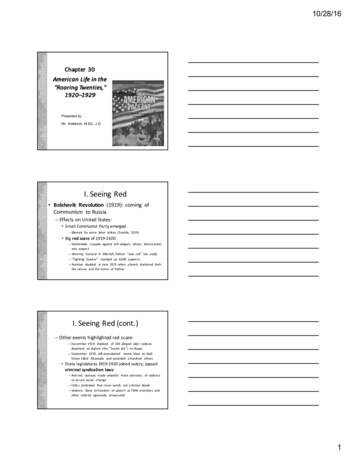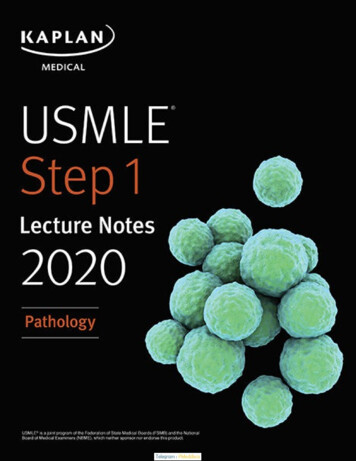
Transcription
10/28/16Chapter 30American Life in the"Roaring Twenties,"1920–1929Presented by:Mr. Anderson, M.Ed., J.D.I. Seeing Red Bolshevik Revolution (1919): coming ofCommunism to Russia– Effects on United States: Small Communist Party emerged– Blamed for some labor strikes (Seattle, 1919) Big red scare of 1919-1920:– Nationwide crusade against left-wingers whose Americanismwas suspect– Attorney General A. Mitchell Palmer “saw red” too easily– “Fighting Quaker” rounded up 6,000 suspects– Number doubled in June 1919 when a bomb shattered boththe nerves and the home of PalmerI. Seeing Red (cont.)– Other events highlighted red scare:– December 1919: shipload of 249 alleged alien radicalsdeported on Buford (the “Soviet Ark”) to Russia– September 1920, still-unexplained bomb blast on WallStreet killed 38 people and wounded a hundred others State legislatures 1919-1920 joined outcry; passedcriminal syndicalism laws:– Anti-red statutes made unlawful mere advocacy of violenceto secure social change– Critics protested that mere words not criminal deeds– Violence done to freedom of speech as IWW members andother radicals vigorously prosecuted1
10/28/16p693I. Seeing Red (cont.)– In 1920 five New York state legislators, all lawfully elected,denied seats because they were Socialists Conservatives used red scare to break fledgling unions:– Unions called for “closed” or all-union shop; this wasdenounced as “Sovietism in disguise”– Employers hailed their antiunion campaign for “open” shopas American plan Anti-redism and antiforeignism reflected in notoriouscase—regarded by liberals as “judicial lynching”– Nicola Sacco and Bartholomeo Vanzetti convicted in 1921 ofmurder of a Mass. Paymaster and his guardI. Seeing Red (cont.)– Jury and judge prejudiced against defenders because theywere Italians, atheists, anarchists, and draft dodgers– Liberals and radicals the world over rallied to their defense– Case dragged on for over six years until 1917 whencondemned men electrocuted– Communists and radicals had two martyrs in “classstruggle”2
10/28/16II. Hooded Hoodlums of the KKK New Ku Klux Klan:– Resembled antiforeign “nativist” movement of1850s rather than antiblack nightriders of 1860s: Antiforeign, anti-Catholic, antiblack, anti-Jewish,antipacifists, anti-Communist, anti-internationalist, antievolutionist, antibootlegger, antigambling, antiadultery, and anti-birth control Pro-Anglo-Saxon, pro-“native” American, proProtestantII. Hooded Hoodlums of the KKK(cont.)– Klan betokened extremist, ultraconservativeuprising against: Forces of diversity and modernity transformingAmerican culture Spread rapidly in Midwest and Bible Belt South whereProtestant Fundamentalism thrived Mid-1920s peak had five million dues-payingmembers and wielded potent political influence “Knights of the Invisible Empire” included amongofficials Imperial Wizards, Grand Goblins, KingKleagles, and other horrendous “kreatures”II. Hooded Hoodlums of the KKK(cont.) Things of KKK:– Impressive “konclaves,” huge flag-waving parades– Chief warning was blazing cross– Principle weapon bloodied lash, supplemented bytar and feathers– Rallying songs and brutal slogan3
10/28/16p694II. Hooded Hoodlums of the KKK(cont.) Collapsed in late 1920s in part because ofcorruption– 10 initiation fee, of which 4 a kickback to localorganization as incentive to recruit– KKK a manifestation of intolerance and prejudiceagainst pace of social change in 1920s– Civil rights activists fought in vain for legislationmaking lynching a federal crimeIII. Stemming the Foreign Flood Isolationist America (1920s), ingrown andprovincial, had little use for immigrants: 800,000 came in 1920-19212/3 from southern and eastern EuropeAmericans recoiled at these “New Immigrants”Congress passed Emergency Quota Act 1921– Newcomers from Europe restricted to a quota Immigration Act of 1924 replaced Emergency Act– Quota cut from 3% to 2%– National origins base shifted from census of 1910 to 18904
10/28/16III. Stemming the Foreign Flood(cont.)– Southern Europeans bitterly denounced device as discriminatory– Purpose was to freeze America's existing racial composition,which was largely northern Europeans– Slammed door absolutely against Japanese immigrants» “Hate America” rallies erupted in Japan– Exempt from quota system were Canadian and Latin Americans—» Easy to attract for jobs when times good» Easy to send home when times bad Effected pivotal departure in American policy– Claimed nation was filling up—“No Vacancy” sign– By 1931 more foreigners left than arrivedp695III. Stemming the Foreign Flood(cont.)– Quotas caused America to sacrifice some of itstradition of freedom and opportunity As well as its future ethnic diversity (see Figure 30.1)– Immigration Act of 1924 marked end of era—– Virtually unrestricted immigration had brought some 35million newcomers, mostly from Europe– Immigrant tide now cut off– Left on American shores a patchwork of ethnic communitiesseparated by language, religion, and customs– “Cultural pluralists” opposed immigration restrictionbecause they celebrated ethnic identity and cultural crossfertilization5
10/28/16Figur e 30-1 p696IV. The Prohibition “Experiment” Prohibition—– Last cause of progressive reform movement– Eighteenth Amendment: (1919): authorizedprohibition (See Appendix) Implemented by Volstead Act passed by Congress in1919 Made world “safe for hypocrisy” Legal abolition of alcohol especially popular in Southand Westp6976
10/28/16IV. The Prohibition “Experiment”(cont.) In West, prohibition an attack on vices associated withwestern saloons (public drunkenness, prostitution, etc.) Strong opposition to “dry” amendment in larger easterncities– Especially for “wet” foreign-born people– Sociability built around drinking Most Americans assumed prohibition had come to stay Prohibitionists naïve:– Overlooked tenacious American tradition of strong drink– Overlooked weak control by central government, especiallyover private livesp698p6997
10/28/16IV. The Prohibition “Experiment”(cont.)– Federal government had never satisfactorily enforced a lawthat majority of people or strong minority rejected– Lawmakers could not legislate away thirst Peculiar conditions hampered enforcement:– Wisdom of further self-denial after war– Slaking thirst became cherished personal liberty– Wets believed way to repeal was to violate law on large scale– Solders complained prohibition “put over” on them while theywere “over there”– Workers bemoaned loss of cheap beerIV. The Prohibition “Experiment”(cont.)– Flaming youth thought it “smart” to swill bootleg liquor– Millions of older citizens found forbidden fruit fascinating asthey engaged in “bar hunts” Might have been more successful if there had beenlarge army of enforcement officials– Federal agencies understaffed– Underpaid snoopers susceptible to bribery Prohibition simply did not prohibit:– “Men only” corner saloons replaced by “speakeasies”– Hard liquor drunk by men and women– Zeal of American prohibition agents strained relations withCanadaIV. The Prohibition “Experience”(cont.)– Worst of homemade “rotgut” produced blindness, even death» Bootlegger worked in partnership with undertaker Yet “noble experiment” not entirely a failure:– Bank savings increased– Absenteeism in industry decreased– Death from alcoholism and cirrhosis declined– Less alcohol consumed than in days before prohibition8
10/28/16V. The Golden Age of Gangsterism Prohibition spawned shocking crimes:– Profits of illegal alcohol led to bribery of police– Violent wars in big cities between rival gangs Rival triggerman “erased” bootlegging competitorsChicago (1920s): 500 mobsters murderedArrests few and convictions fewerChicago most spectacular example of lawlessness:– 1925 “Scarface” Al Capone began six years of gang warfare– Zoomed through streets in armor-plated car with bulletproofwindowsp700V. The Golden Age of Gangsterism(cont.)– “Public Enemy Number One,” could not be convicted ofmassacre on St. Valentine's Day 1929» Of seven unarmed members of rival gang» After serving 11 years for income tax evasion, Caponereleased as syphilitic wreck Gangsters moved into other profitable and illicitactivities:– Prostitution, gambling, narcotics– Honest merchants forced to pay “protection money”– Racketeers invaded ranks of local labor unions as organizersand promoters– Organized crime came to be one of nation's biggestbusinesses9
10/28/16V. The Golden Age of Gangsterism(cont.)– By 1930, annual “take” of underworld 12 to 18 billion Criminal callousness sank to new depths in 1923:– Kidnapping for ransom and eventual murder of infant son ofaviator-hero Charles A Lindbergh– Congress passed Lindbergh Law: making interstateabduction in certain circumstances a death-penalty offenseVI. Monkey Business in Tennessee Educational strides in 1920s:– More states required students to remain in schooluntil age 16 or 18, or until graduation– High school graduation rates doubled in 1920s Change in educational theory by John Dewey Principles of “learning by doing”– So-called progressive education with its greater“permissiveness”– Believed workbench as essential as blackboard– “Education for life” should be primary goal of teacherVI. Monkey Business in Tennessee(cont.)– Science made advancements: Health programs, launched by Rockefeller Foundation inSouth in 1909, wiped out hookworm by 1920s Better nutrition and health care increased lifeexpectancy of newborns (from 50 years in 1901 to 59years in 1929) Science and progressive education faced unfriendly fireof newly organized Fundamentalists– Numerous attempts made to secure laws prohibiting teachingof evolution– Tennessee, heart of so-called Bible Belt South, where spirit ofevangelical religion robust10
10/28/16VI. Monkey Business in Tennessee(cont.) “Monkey Trial”:– In 1925, Dayton high-school biology teacherJohn T. Scopes indicted for teaching evolution Defended by nationally renowned attorneys– William Jennings Bryan made to appear foolishby famed criminal lawyer Clarence Darrow Five days after trial, Bryan died of strokep701VI. Monkey Business in Tennessee(cont.) Historic clash between theology and biologyproved inconclusive:– Scopes found guilty and fined 100– Tennessee supreme court upheld law, but setaside fine on technicality– Fundamentalists won only hollow victory Fundamentalism (emphasis on literal reading of Bible)– Remained vibrant force in American spiritual life– Strong in Baptist Church and rapidly growing Churches ofChrist, organized in 190611
10/28/16VII. The Mass-Consumption Economy Prosperity put “roar” into twenties:– Recent war and Treasury Secretary AndrewMellon's tax policies: Favored rapid expansion of capital investment New machinery increased productivity Assembly-line production reached perfection byHenry Ford's factories where a finished automobileemerged every ten seconds New industries sproutedVII. The Mass-ConsumptionEconomy (cont.) Automobile:– Now became carriage of common citizen– By 1930 Americans owned almost 30 million cars– Created shift in character of economy: American manufacturers– Mastered problems of production– Shifted focus to consumption– Could they find mass markets for goods? New arm of American commerce came into being:VII. The Mass-ConsumptionEconomy (cont.)– Advertising Bruce Barton published best seller: The Man NobodyKnows:– Provocative thesis: Jesus Christ greatest adman of all time– “Every advertising man ought to study the parables of Jesus”– “Marvelously condensed, as all good advertising should be”– Christ's executive ability: “He picked up twelve men from thebottom ranks of business and forged them into an organizationthat conquered the world”12
10/28/16VII. The Mass-ConsumptionEconomy (cont.)– Sports: Became big business in consumption economy Heroes like George H. (“Babe”) Ruth far better knownthan most statesmen Yankee Stadium became “house that Ruth built” In 1921 heavyweight champion, Jack Dempsey,knocked out light heavyweight George Carpentier– Jersey City crowd paid more than a million dollars– First in series of million-dollar “gates” in 1920sp702VII. The Mass-ConsumptionEconomy (cont.)– Buying on credit; another innovation of postwareconomy: “Possess today and pay tomorrow” was message People went into debt to own all kinds of newmarvels—refrigerators, vacuum cleaners, cars andradios—now Prosperity accumulated an overhanging cloud of debt Economy became increasingly vulnerable to disruptionsof credit structure13
10/28/16VIII. Putting America on Rubber Tires Machinery was new messiah—and automobileits principal prophet– Automobile New industrial system:– Assembly-line methods– Mass-production techniques Americans adapted rather than invented gasolineengine:– Europeans can claim original honor– 1890s—daring American inventors and promoters– Henry Ford and Ransom E. Olds developed infant automotiveindustryp703VIII. Putting America on RubberTires (cont.) By 1910 sixty-nine car companies rolled out totalannual production of 181,000 units Detroit became motorcar capital of America Scientific Management:– Stopwatch efficiency techniques of Frederick W. Taylor– Eliminate wasted motion Henry Ford:– More than any other individual, put America on rubber tires– His Model T (“Tin Lizzie”)» Cheap, rugged, and reasonably reliable, though roughand clattering» Parts highly standardized14
10/28/16VIII. Putting America on Rubber(cont.)– Devoted himself to gospel of standardization– Grasped and applied technique of moving assembly line—Fordism– Sold Ford roadster for 260 (see Figure 30.2)– Fordism caught fire outside United States– Flood of Fords phenomenal:» In 1914 “Automobile Wizard” turned out his 500,000thModel T» By 1930 total had risen to 20 million» By 1929, 26 million motor vehicles registered—one forevery 4.9 American (see Figure 30.3)Figur e 30-2 p704Figur e 30-3 p70415
10/28/16IX. The Advent
Chapter 30 American Life in the "Roaring Twenties," 1920–1929 Presented by: Mr. Anderson, M.Ed., J.D. I. Seeing Red Bolshevik Revolution (1919): coming of Communism to Russia –Effects on United States: Small Communist Party emerged – Blamed for some labor strikes (Seattle, 1919) Big red scareof 1919-1920:










